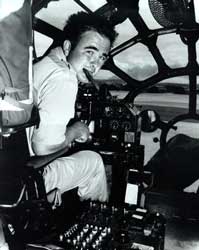
Major Charles W Sweeney was the commander of the B-29 bomber that dropped the Fat Man atomic bomb on Nagasaki, Japan on August 9, 1945. The bomber was nicknamed Bockscar. It was named after its regular command pilot, Frederick Bock.
Bockscar was used in four additional non-atomic combat bombing missions over Japan in July and August 1945.
Retired December 27, 1979
Brigadier General Charles W Sweeney was born in Lowell, MA in 1919. He graduated from North Quincy High School in 1937. After graduating from high school, he attended evening classes at Boston University and also at Purdue University.
Charles Sweeney joined the Army Air Corps as an aviation cadet on April 28, 1941. Receiving his commission as a pilot in the Army Air Corps as an aviation cadet on April 28, 1941. Receiving his commission as a pilot in the Army Air Corps in December 1941, Lieutenant Sweeney spent two years at Jefferson Proving Grounds Ind. From the proving grounds in 1943, Charles Sweeney, now a Captain, moved to Eglin Field, Florida, where he served as an operations officer and also a test pilot.
In 1944 he was promoted to the rank of Major in the Army of the United States. At this time he was acting as a B-29 pilot instructor at Grand Island, Nebraska. Later in the same year, Major Sweeney was reassigned to Wendover Field, Utah and it was here that he began working in the "Silver Plate" project, the code name of the pilot and crew training program for the coming World War II atomic missions.
On May 4, 1945 (at the age of 25 and with the rank of Major) Charles Sweeney became commander of the 393d Bombardment Squadron, a B-29 unit, which seven weeks later (on June, 1945) flew to a base on Tinian in the Mariana Islands.
It was during August 1945 that Major Sweeney flew the history-making missions and dropped the bomb which brought World War II to a close.
In November 1945, Major Sweeney and the 393d Bombardment Squadron returned home to Roswell Air Force Base, NM. His mission at Roswell was to train aircrews for a third atomic mission -- a peacetime experiment on Bikini. Just a few months later on June 28, 1946, he was discharged from active duty with the rank of Lieutenant Colonel.
Colonel Sweeney, on Feb. 21, 1956, was appointed Wing Commander by Governor Christian A Herter. Also in 1956, the unit was again re-designated as the 102d Air Defense Wing, and on April 6, 1956, Colonel Sweeney received his promotion to the rank of Bigadier Gneral. 1958 saw the wing receive its present designation as the 102d Tactical Fighter Wing.
General Sweeney is a command pilot with more than 5,000 military flying hours and he is the holder of the Silver Star, Air Medal, National Defense Medal, American Theater Service Medal, Asiatic-Pacific Service Medal with two bronze stars, World War II Victory Medal, Occupation of Japan Medal, National Defense Service Medal, Armed Forces Reserve Medal, Air Force Longevity Medal and the Massachusetts Military Service Medal.
UNUSUAL EXPERIENCES:
Brigadier General Charles W Sweeney is the man who piloted a B-29 Superfortress bomber deep into the heart of Japan to drop, in military combat, the world's second atomic bomb. This was the nuclear blast that brought the warlords to their imperial knees and closed the last active chapter of history's most destructive war.
It all began on Aug. 6, 1945, when 25 year old General Sweeney, then a Major, piloted a photographic and observer B-29 close beside the now legendary B-29 "Enola Gay" (itself flown by General Sweeney's close friend, Colonel Paul W Tibbetts Jr).
On this mission, the first epochal A-Bomb decimated Hiroshima.
Due to the reluctance of the Japanese to surrender, despite this destructive blow, it was decided that the second bomb should be dropped on August 9, Major Sweeney was named to pilot the second B-29 atomic bomber, this time over Nagasaki.
On the second raid, Major Sweeney not only had weather problems, but mechanical trouble prevented him from pumping gas to his engines from special bomb-bay tanks. Only his special training on how to squeeze every possible mile from his initial supply kept the plane aloft.
Despite the unfortunate incidents, the mission was completed. Through a break in the heavy cloud formations, the deadly missile hurtled to pinpoint accuracy into history, destroying 60 percent of Nagasaki. These two historic missions virtually and effectively end ed the war against Japan, and with it the Second World War.